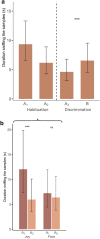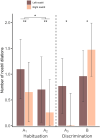Horses discriminate human body odors between fear and joy contexts in a habituation-discrimination protocol
- PMID: 36841856
- PMCID: PMC9968287
- DOI: 10.1038/s41598-023-30119-8
Horses discriminate human body odors between fear and joy contexts in a habituation-discrimination protocol
Abstract
Animals are widely believed to sense human emotions through smell. Chemoreception is the most primitive and ubiquitous sense, and brain regions responsible for processing smells are among the oldest structures in mammalian evolution. Thus, chemosignals might be involved in interspecies communication. The communication of emotions is essential for social interactions, but very few studies have clearly shown that animals can sense human emotions through smell. We used a habituation-discrimination protocol to test whether horses can discriminate between human odors produced while feeling fear vs. joy. Horses were presented with sweat odors of humans who reported feeling fear or joy while watching a horror movie or a comedy, respectively. A first odor was presented twice in successive trials (habituation), and then, the same odor and a novel odor were presented simultaneously (discrimination). The two odors were from the same human in the fear or joy condition; the experimenter and the observer were blinded to the condition. Horses sniffed the novel odor longer than the repeated odor, indicating they discriminated between human odors produced in fear and joy contexts. Moreover, differences in habituation speed and asymmetric nostril use according to odor suggest differences in the emotional processing of the two odors.
© 2023. The Author(s).
Conflict of interest statement
The authors declare no competing interests.
Figures





Similar articles
-
Do sheep (Ovis aries) discriminate human emotional odors?Anim Cogn. 2024 Jul 26;27(1):51. doi: 10.1007/s10071-024-01895-1. Anim Cogn. 2024. PMID: 39060454 Free PMC article.
-
Testing for odor discrimination and habituation in mice.J Vis Exp. 2015 May 5;(99):e52615. doi: 10.3791/52615. J Vis Exp. 2015. PMID: 25992586 Free PMC article.
-
Interspecies transmission of emotional information via chemosignals: from humans to dogs (Canis lupus familiaris).Anim Cogn. 2018 Jan;21(1):67-78. doi: 10.1007/s10071-017-1139-x. Epub 2017 Oct 7. Anim Cogn. 2018. PMID: 28988316
-
The smell of danger: a behavioral and neural analysis of predator odor-induced fear.Neurosci Biobehav Rev. 2005;29(8):1157-67. doi: 10.1016/j.neubiorev.2005.04.008. Epub 2005 Aug 10. Neurosci Biobehav Rev. 2005. PMID: 16095694 Review.
-
The scent of emotions: A systematic review of human intra- and interspecific chemical communication of emotions.Brain Behav. 2020 May;10(5):e01585. doi: 10.1002/brb3.1585. Epub 2020 Mar 25. Brain Behav. 2020. PMID: 32212329 Free PMC article.
Cited by
-
Do sheep (Ovis aries) discriminate human emotional odors?Anim Cogn. 2024 Jul 26;27(1):51. doi: 10.1007/s10071-024-01895-1. Anim Cogn. 2024. PMID: 39060454 Free PMC article.
-
Behavioral responses of domestic cats to human odor.PLoS One. 2025 May 28;20(5):e0324016. doi: 10.1371/journal.pone.0324016. eCollection 2025. PLoS One. 2025. PMID: 40434966 Free PMC article.
-
Emotional contagion of fear and joy from humans to horses using a combination of facial and vocal cues.Sci Rep. 2025 May 21;15(1):17689. doi: 10.1038/s41598-025-98794-3. Sci Rep. 2025. PMID: 40399542 Free PMC article.
-
Seasonal Variation of Laboratory Animals as a Consideration for Research Reproducibility.Comp Med. 2023 Aug 27;73(4):255-259. doi: 10.30802/AALAS-CM-23-000033. Comp Med. 2023. PMID: 37550067 Free PMC article.
-
A Review of the Effects of Some Extrinsic Factors on Mice Used in Research.Comp Med. 2023 Dec 1;73(6):413-431. doi: 10.30802/AALAS-CM-23-000028. Comp Med. 2023. PMID: 38217072 Free PMC article. Review.
References
-
- Briefer EF, Le Comber S. Vocal expression of emotions in mammals: mechanisms of production and evidence. J. Zool. 2012;288:1–20. doi: 10.1111/j.1469-7998.2012.00920.x. - DOI
-
- Galvan, M. & Vonk, J. Man’s other best friend: domestic cats (F. silvestris catus) and their discrimination of human emotion cues. Anim. Cogn.19, 193–205 (2016). - PubMed
Publication types
MeSH terms
LinkOut - more resources
Full Text Sources

